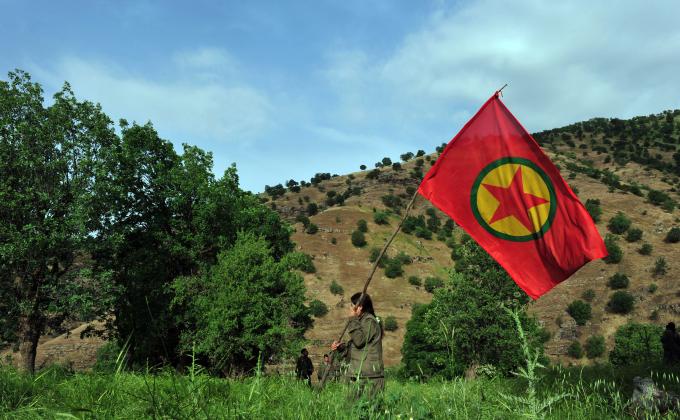On 26 July 2024, the European Union (EU) added the group The Base to its list of terrorist entities, which now counts 22 entities (all foreign-based) and 15 individuals. This decision is particularly significant as this is the first far-right entity listed by the EU, indicating a change in the threat landscape and a clear political shift of counter-terrorism priorities.
The Base is already designated as a terrorist organisation by Canada (2021), the United Kingdom (2021), Australia (2021), and New Zealand (2022). Although the United States (US) considers domestic terrorism a key threat (including groups such as The Base), no domestic terrorist organisations are designated as such, which remains a contentious issue. This article offers some insights into the reasoning behind this EU decision, and its implications, as well as some background information on The Base.
What is The Base?
The Base is a networked organisation formed in 2018 in the US. It has come together as an alleged paramilitary/survivalist outfit, although its ideology is clearly inspired by neo-nazism, anti-semitic conspiracies, and “Siege Culture”. Its members adhere to white supremacism, and are convinced that the white race is threatened by immigration, interracial marriages, and declining birthrates, amongst other issues. They see diversity in all its forms (including ethnic or sexual) as an existential threat, and as a remedy are keen to foster the emergence of a separatist and all-white ethnostate.
The group adheres to so-called “militant accelerationism,” that is, the usage of political violence or terrorism “in pursuit of the destruction of the physical manifestations [of..] modernity, liberalism, and capitalism.” Similar to several other far-right groups, such as Atomwaffen Division or Feuerkrieg Division, their strategy is to exploit existing crises and divisions within the society to effectively “accelerate” its collapse, in the hope of shaping a new world order on its ashes. Specifically, through acts of political violence and terrorism, they aim to provoke a race war, which they believe is already underway, to ensure separation of races, cultures, and ideologies into neat ethnically-based regions or states. Although the strategy of accelerationism is currently mostly associated to right-wing violent extremism, it is in fact common to many terrorist organisations sharing the belief that some fundamental revolution is underway, or possible, and that they constitute the vanguard to trigger it. On the jihadi side, this theory was notably articulated in Abu Bakr Naji’s “Management of Savagery,” which suggested the need to destabilise Muslim countries through terrorism in order to facilitate the emergence of a caliphate.
The Base is a transnational organisation, with a relatively small but international membership, mainly across North America, Australia and Europe. It has some structure and leadership, including a central “vetting process” for new recruits, but it also promotes decentralized “leaderless resistance” as a conscious model, that is the creation of small autonomous cells of two to three members in order to limit the risks of infiltration and criminal investigation by law enforcement services. This model is reminiscent of al-Qaeda’s system of franchises and relatively autonomous international cells, although on a lower scale. Interestingly, the name “The Base” is the English translation of “al-Qaeda” (it is unclear whether this was intentional or not, although one of the group’s leaders expressed admiration on social media for the jihadi group’s tactics).
Albeit US-centred, The Base’s ideas and narratives are transferable to other countries, facilitated by the use of English language in global online platforms (such as Telegram or Whatsapp). Some of the seminal works underpinning accelerationist groups, such as James Mason’s Siege, are available in English. English is also the lingua franca of the Terrorgram collective, a network of Telegram accounts promoting “accelerationist” ideas, which “produce[s] and disseminate[s] violent propaganda to encourage those who consume its content to engage in terrorist activity.” Terrorgram inspired the perpetrator of the terrorist attack against the LGBTQI+ community in Bratislava, in October 2022, and its members may have provided some practical assistance in the process of attack preparation.
Plots linked to The Base
In addition to spreading hatred, inciting violence, and training for civil warfare, The Base has been directly involved in a number of violent incidents in the US. In 2021, three members were convicted for plotting violent actions, including murder and derailing trains, in order to create chaos and accelerate the collapse of the US. In 2020, three other members were arrested for plotting to kill a married couple for their alleged role within the anti-fascist organisation Antifa. The Base is also responsible for the defacing of several synagogues in 2019, during their so-called “Operation Kristallnacht” (in reference to a Nazi pogrom against Jews throughout Nazi Germany in 1938).
In Europe, the group seems to have developed a growing following over the past few years, leading to some violent acts or plots. For example, the burning of a mink farm in Sweden, in 2019, was allegedly caused by a local eco-fascist wing of the group.
In December 2021, the District Court of Rotterdam, in the Netherlands, convicted two individuals for membership of a terrorist organisation and incitement to commit a terrorist offence (see decision 1 and decision 2). The two individuals had been vetted by leaders of The Base, and jointly established a Dutch cell. In addition to recruiting some individuals, or attempting to, they were active on several Telegram and Whatsapp groups, posting racist, anti-semitic, and homophobic content. They also clearly incited violence against minorities. In its decisions, the court ruled that The Base meets indeed the criteria to be considered a terrorist organisation, according to Dutch law, i.e. an international organisation with a certain permanence, structure, and membership, and terrorist intent. Both individuals were convicted to 24 months in prison, and three years probation period. This decision was confirmed by the Court of Appeal in The Hague, in April 2023.
In November 2023, in a major pan-European police operation coordinated by Europol and Eurojust, five individuals were arrested and seven more interrogated by police. The operation was conducted simultaneously in Belgium, Croatia, Italy, Lithuania, The Netherlands and Romania. The individuals allegedly belonged to The Base and are suspected of disseminating violent extremist propaganda, recruiting new members, and sharing manuals for 3D-printed weapons. Some of the suspects had already written a manifesto, had access to weapons, and were considered at risk of launching imminent action.
Why is the EU listing The Base now?
As The Base has become the first far-right entity listed by the EU on its terrorist list, it is important to understand the process and motivations leading to this decision. We see two main factors explaining this decision: the perceived growing threat from far-right violent extremism, and a political desire to take a stronger stance against it.
Far-right terrorism constitutes a potent threat to European security. Data amassed by Europol lists fourteen “right-wing terrorist attacks (completed, failed and foiled)” between 2020 and 2022. The University of Oslo’s C-REX report for 2023 highlights 93 severe attacks motivated by extreme-right wing ideology in Western Europe in 2022 alone. 40 percent of these were perpetrated by lone actors, hence supporting evidence on the diffuse and bottom-up nature of the threat. At the same time, however, 27 percent of these attacks were conducted by organised far-right groups and their affiliates, demonstrating a certain intent and ability to cause serious violence in Europe. In other words, while worrying about the emergence of the next Anders Breivik, an almost archetypal lone actor who staged two successful terrorist attacks within the span of one day in Norway on 22 July 2011, the European security authorities cannot forget that in the recent past the likes of the Nordic Resistance Movement have been able to coordinate “simultaneous acts of low-level violence in different European countries.” At the same time, French or German violent organisations have also been preparing themselves for civil wars, assassinations of prominent politicians, or even conducting coup attempts.
Several European countries assess that far-right violent extremism and terrorism is on the rise. In France, the threat from far-right terrorism has been considered to be on the rise since 2015, with at least ten terrorist plots foiled since 2017. Within this ideology, the intelligence service DGSI notably singles out the threat from accelerationism. The Dutch intelligence service AIVD considers that right-wing extremists now “more openly” express their hatred, and that there is a greater “admiration for violence” amongst some of them. The NCTV has also emphasised specifically the “undiminished threat” from accelerationism as one variable justifying raising the threat level to “substantial” in December 2023. The Danish intelligence service PET assessed in its 2023 report that accelerationism and the Siege-culture “exacerbates the terrorist threat from right-wing extremism and adds to the unpredictability in the threat picture”. This finding came after a 16-year-old Danish teen was convicted to five and a half years for membership to the Feuerkrieg Division, an international neo-nazi accelerationist group.
In Finland, the intelligence service Supo considers that the threat from far-right terrorism has increased, arguably reaching similar levels to the jihadi threat. Quite significantly, the first-ever terrorist convictions related to the far-right ideology in the country, which were related to accelerationism, were handed down in October 2023. In Germany, the Office for the Protection of the Constitution (BfV) has reported that right-wing extremism is already the most active extremist threat in numbers (in terms of members or actions), and that it is growing. Interior Minister Nancy Faeser made clear it was considered the biggest threat faced by German society.
Recognising this growing threat, the German federal government announced last February a broad package of measures to further combat right-wing extremism. There, the Minister of Interior Nancy Faeser claimed: “We must do everything in our power to prevent this abhorrent ideology from eating into our society even further”. While the German announcement is quite exceptional at the European level, it is clear from the analysis above that many security services across Europe are taking the threat from right-wing extremism very seriously. This results notably in more criminal investigations and police operations targeting far-right groups or individuals, as the ones against The Base mentioned above.
The logic of sanctions
One of the key measures against far-right extremism that seems to be on the rise across Europe is the proscription of organisations. According to a recent research by Michael C. Zeller and Michael Vaughan, such proscriptions have become “more widespread and more frequent in recent years”, as the use of this legal measure has gained “greater acceptance”. For instance, the UK proscribed its first right-wing extremist organisation in 2016, and has banned five more organisations since – the latest being the ban of Terrorgram Collective last April. In France, seventeen far-right organisations have been proscribed since 2017, almost as many as between 1944 and 2016, and also more than organisations linked to any other ideology.
Although proscription is indeed possible at the national level, three key reasons seem to explain the decision to add The Base on the EU’s terrorism list: signalling, opportunity, and efficacy.
First, political signalling. Some EU member states have come to the conclusion that the moment had come to add the first right-wing organisation on the EU’s terrorist list, in light of the rising threat from far-right terrorism described above. Indeed, the list was so far dominated by Islamist organisations, and the new addition clearly signals the diversification of the threat landscape in Europe. As noted by Zeller and Vaughan, sanctions and proscription decisions are highly political and reflective of the socio-political and security contexts.
Furthermore, the EU’s decision highlights prominently that right-wing extremism can also lead to terrorism. Whereas, proscription at the national level is often based on considerations related to respect for the law and constitutional order, they remain below the threshold of terrorism. In this regard, the EU’s decision is a step up not only in extending the sanctions to the entire EU territory, but also in signalling that The Base is more than just a fringe extremist group. The Netherlands were first movers in this regard, designating The Base as a terrorist organisation and imposing sanctions thereupon, in January 2024.
This signalling is directed at multiple audiences. On the one hand, it is aimed at EU governments and their security services, encouraging everyone to play their part by prioritising this phenomenon. On the other hand, it is aimed at increasing pressure on right-wing organisations and individuals, to warn them against drifting further towards (violent) extremism.
Second, opportunity. The EU’s decision had been in the making for some time already. The German presidency of the EU had already tested the waters informally in 2020 (although in more theoretical terms, and not against The Base specifically), whereas the French presidency of the EU sought to revitalise the EU’s sanctions regimes in 2022. However, EU sanctions regime follow strict procedures and criteria. To initiate the listing of an entity, there should be a precise motivation based on a decision by a “competent authority”, which in practice means a court decision or advanced criminal investigation, demonstrating the terrorist nature of the group. Then, following the proposal by an EU member state, the case of an entity will be discussed through various EU working groups, starting in the group specialised on sanctions (so-called COMET WP), where all EU member states are represented through officials, and allowed to intervene. Decisions are taken by consensus, and must be approved by the Council of the EU in a unanimous vote.
The court decisions rendered in the Netherlands in 2021 and 2023, against members of The Base, and the decision of the Dutch government to list The Base as a terrorist organisation, produced the necessary material to initiate a decision against the group at the EU-level. Furthermore, the Belgian rotating presidency of the Council of the EU was all the more open to consider this suggestion given that The Base has a presence in Belgium, as revealed by the Europol-led operation mentioned above. The fact that The Base is a relatively well-structured organisation, with clear terrorist intents, and with transnational ramifications in several EU countries, made it a particularly good case to be considered as the first far-right group to be listed.
Third, efficacy. Adding a group like The Base on the EU’s terrorist list brings multiple advantages, beyond mere political “signalling”. It allows the EU and its member states to better confront transnational organisations, and freeze their assets in every EU country at the same time, creating an element of surprise, and hampering members’ ability to otherwise move easily across borders to avoid scrutiny. Furthermore, the listing creates an obligation for all member states to inform each other on new developments with regard to the entity listed, and to offer each other the “widest possible assistance” to prevent terrorism, notably in terms of police and judiciary cooperation.
Conclusion
The listing of the far-right accelerationist group The Base on the EU’s terrorist list is a significant development in that it reflects a shifting threat perception in Europe, and signals a desire to enhance cooperation against all forms of violent extremism and terrorism. But, it is also a test case - at times some European governments are themselves drifting to the far-right and showing some complacency towards this particular threat. Furthermore, at times of growing fears about Russia’s interference activities and support to far-right extremism across Europe, the designation of an organisation whose founder and leader resides in Russia under Moscow’s protection adds a notable twist to the story.
This article represents the views of the author(s) solely. ICCT is an independent foundation, and takes no institutional positions on matters of policy unless clearly stated otherwise.
Photocredit: 1000 Words/Shutterstock








